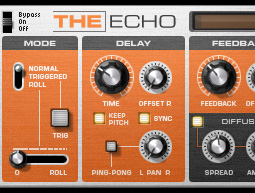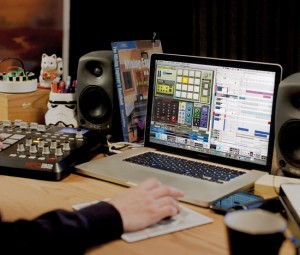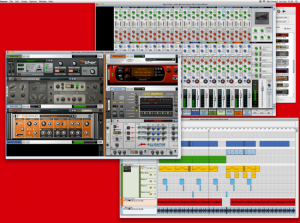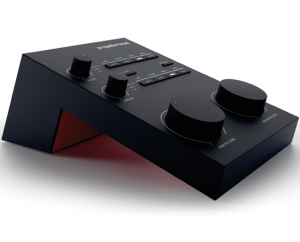Review: Propellerhead Reason 6 and Balance by Bo Boddie
Propellerhead’s Reason holds a unique place in the world of DAW and music-making software. While it has always been a very powerful tool for music-making, it never went head-to-head with the “big” names in the DAW business because unlike Pro Tools or Nuendo, Logic or Live, it was never designed to be an audio recorder. Instead, Reason has always been about its killer collection of virtual instruments, effects, and easy-to-use sequencer.
However, this all changed in September of 2009 when Propellerhead released a new product called Record, which did exactly as its moniker described. Interestingly, and in my mind, a little counter-intuitively, Record was another standalone product.
Record could be easily incorporated with Reason’s sequencer and rack of virtual gear, but to me, this methodology was old-hat: Reason users were already accustomed to slaving Reason to other DAW’s (using ReWire, another popular Propellerhead technology) so that audio recording could be incorporated into Reason projects. Record was a solution, but not the fully integrated solution Reason users had been clamoring for. [Ed Note: Propellerhead’s Record/Reason DUO product did fully integrate the two programs.]
In September of this year, Propellerhead took the next step with the introduction of Reason 6, which fully incorporates Record’s DAW functionality directly into Reason.
From here forward, Record no longer exists, and we are back to having one all-in product from Propellerhead: Reason 6. Along with the debut of Reason 6, Propellerhead has also announced Balance, a 2-in 2-out audio interface designed specifically for use with their software (although it works perfectly with all other products as well).
I’ve spent the last few weeks working with Balance and Reason 6 and will be sharing my impressions here.
IN ITS OWN, VERY STABLE WORLD
I am no stranger to Reason; I have been a user since version 2.0 and have become a big fan of the software over the years. And I think it’s important to distinguish that while Reason may appear to behave and operate in a manner similar to other DAWs, it is quite unique in that it lives – literally in the sense that it does not support third party plug-ins – in its own world.
First and foremost Reason is a program for making music; it does not address all of the specific utility-oriented features the other DAWs do, but rather, orients itself specifically towards efficient and extreme flexibility when it comes to creating music.
Back in the dark ages of 2003, my personal attraction to Reason was simple: I needed something specifically to create fully produced music that was efficient and inexpensive. I had just started composing music for television, and I didn’t have the resources to really delve into creating a fully featured MIDI-oriented studio for that purpose. Although software instruments were well on their way at that point, they tended to eat up system resources quickly – especially the Mac G4 I was running at that time. I did a little research and decided to give Reason a try, attracted to its self-contained simplicity and bang-for-buck.
What I immediately found amazing about Reason, and this is something that still holds true to this day, was its INCREDIBLE efficiency. I was amazed at the huge number of samples, virtual synths, and effects that I could instantiate in a single project, without coming close to maxing out the CPU. All of a sudden, Reason was my go-to when I needed to sit down and write music; it gave me a sense of security – that I would easily be able to accomplish what I needed to without having to worry about running out of system resources, and all I had to do to use it was a plug a USB keyboard into my laptop…no dongles or brand-specific interfaces necessary.
The other major appeal was and still is that I cannot recall a time when Reason has crashed on me. Ever. And this is a program that I still use regularly. While Pro Tools is my platform for recording and mixing, Reason and Logic make up my composing rig.
WHAT’S NEW IN REASON 6
Reason 6 brings some great new features to the table. (Many of these tools and functions will be familiar to Record and Reason + Record users):
- An SSL-style mixer, complete with compression and 4-band EQ on every channel, master buss compressor, and a control room section.
- Neptune, a pitch correction and voice synthesizer for the rack.
- Great time stretching and pitch shifting algorithms.
- A large recording meter complete with an instrument tuner.
- A set of Line 6 amp emulators for both guitar and bass.
- A comp editor for audio tracks, similar to the quick-swipe comp’ing found in Apple’s Logic.
- An audio export function, which makes it very easy to print stems and output tracks and effects returns for use with other DAW software.
- Ignition Key: a Dongle based USB key for the license. You can also use Internet verification if you are attached to a network.
There are also some brand-new features unique to Reason 6:
- Pulveriser, a dirty sounding distortion generator, compressor, filter and modulator.
- The Echo, a delay based on some classic tape/tube/analog pieces.
- Alligator, a three-band pattern based gate. Great for subtle to radical modulations of whatever source you choose.
- 64-bit!!! This is my favorite new feature, you can now load samples into RAM for days.
- New samples and patches in the Reason Factory Soundbank.
Given that up until I started this review I was running Reason 4.0, there was a lot of new functionality for me to explore. However, given that this program is so easy to use, I was immediately off and running, using all the new features with ease. I love the new Echo and Pulveriser – both are great for adding grit and character to tracks that need a little extra vibe or thickening.
Pulveriser offers an intense compression effect, referred to as “squash”, a distortion control (“dirt”) that can go from subtle to ripping, and filters and modulation. The addition of a wet/dry control makes blending distorted and clean sounds a snap. I found myself using Pulveriser on virtually every track I could as it provided instant depth and character to even the blandest sources.

The Trigger and Roll modes let you play The Echo as an instrument, creating stutter and repeat effects on the fly.
The Echo is inspired by some of the great tape and analog delay effects of the past like the Space Echo or Echoplex, and includes some cool features that I have not seen in any delay effects before. Specifically, there are three special modes called “trigger”, “duck”, and “roll” which can be used to control delay characteristics.
Trigger does exactly what it says, which is turning the delay on and off at the touch of the button. Roll is a little more interesting in that you can use a crossfader to quickly slide between fully dry and wet signals. Duck is the most unique in that it lowers the dry/wet blend based on the incoming signal; essentially pulling the delay down in level when it receives source, and letting it come back up during pauses, definitely a great timesaver for vocals!
It was especially nice to be able to quickly plug in a guitar or bass and track real audio as well. Although sync’ing earlier version of Reason to Logic or Pro Tools via ReWire was always easy, it is so much more convenient to instantly be able to track ideas without ever leaving the Reason environment.
Reason 6 behaves like most other DAWs in respect to audio. You simply create a track, choose your input, and you’re off to the races. Latency was definitely not an issue here; given the efficiency with which Reason operates I was usually able to keep the playback buffer set at 64 samples which ends up giving around 3 ms of latency monitoring through the software. Additionally, with the Balance interface you can monitor the input, which gives you zero latency performance if necessary.
Perhaps one of the most exciting aspects of Reason 6 is that it is fully 64-bit. What does this mean for the end user? Virtually unlimited RAM access. In theory that means any 64-bit application could access millions of TERAbytes of RAM…overwhelmingly unlikely at this point that any audio application would need access to that kind of memory, but as far as the present is concerned I am now able to utilize all of my RAM for loading samples, which is just fantastic.
It is here that we also see another advantage to Reason’s fully self-contained environment; because all of the effects, soft synths, and samplers are built in, they are all de-facto 64-bit as well. You won’t be waiting for x, y, and z manufacturers to upgrade their plug-ins (or DAW software in some cases) to 64-bit code to fully utilize the full RAM capabilities of the modern computer.
The only real complaint I had with Reason 6 was the quality of the Line 6 guitar and bass amp emulators. To my ear, they just don’t sound as good as some of the other amp emulating plug-ins out there, and because we are talking about Reason, you don’t have easy access to the world of other plug-in options. Reason does not offer support for AU, VST, or RTAS plug-ins, which is fine 99% of the time, and is probably why it offers such a stable environment. I actually found that using the Pulveriser was a great way to breathe life into some of the lackluster amp emulations. But if I really need a realistic sounding guitar or bass track I’d opt to do it via ReWire, or, god forbid, just record a real amplifier!
All in all, Reason 6 is a fantastic update to an already great program. I’ve really enjoyed using it on a regular basis over the last few weeks, and have written several songs and pieces of music with it. Now that you can record straight into Reason, I can safely say that you can get very high quality and competitive sonic results working entirely inside this program, using only the tools available within Reason 6.
And even after so many years of using Reason I haven’t fully plumbed the depths of its features and routing capabilities. It simply does what you need it to do, and takes on new and more complicated tasks with hassle-free ease. If I had one suggestion for Propellerhead it would be to look into a more extensive set of amp modeling tools, as well as the ability to do some rudimentary picture sync. I would love to be able to open video files in Reason!
BALANCING ACT
While testing Reason 6, I used Propellerhead’s new USB audio interface exclusively. Balance has several options for both input and output, as well as some nice sized knobs and a pleasing-to-the-touch rubberized surface coating.
While there are four line inputs, 2 XLR mic inputs (with phantom power), and two 1/4” instrument level inputs, Balance can only record 2 inputs at a time.
There is a nice headphone output with plenty of gain, a few buttons which cover some dedicated functions (more on that later), a master volume knob, and two smaller knobs controlling the preamps or line level trim (depending on the input).
The three little buttons offer some cool features:
- Clip Safe: This feature was definitely designed with non-engineer types in mind. When this button is engaged, Reason records input at two different levels: One at the gain set by the user, and one at a lower level set by the interface itself. If you happen to clip your input pretty hard, you can engage the Clip Safe feature in the software, and as if by magic, you will be able to work with the audio that was recorded at the lower level…so the user doesn’t have to deal with any nasty distortion. Kudos to Propellerhead for coming up with this, as I have seen some appallingly distorted audio come out of the project studio world.
- Meter/Tuner: Pressing this button immediately brings up the large recording meter and tuner.
- Mute/Direct Monitoring: Hitting this button once will mute the output. If you hold it down for a few seconds you can monitor the inputs, eliminating any monitoring latency that might exist with larger projects.
Balance will operate at sample rates up to 96 kHz, and plays very well with core audio, as I also used it with both Logic and Pro Tools 9 without a hitch. Balance also ships with a copy of Reason Essentials, which is a scaled down version of Reason; it has fewer effects and instruments, but still offers a generous complement of features to work with.
Although Balance is more oriented towards the entry-level market it sounds very good and operates very well. Although I wasn’t able to test its sonics against similar interfaces in its class, I definitely didn’t find it noticeably lacking when compared to the Black Lion Audio modified interface I use at home (which is excellent). It was definitely designed with ease-of-use in mind and certainly meets that goal.
If you are a just starting to get into recording and sequencing the Balance and Reason Essentials combo is a great jumping off point. The Clip Safe functionality is definitely a huge bonus for those who just want to plug in and record without worry, and the software is incredibly easy to start using right away, with enough depth available down the line to accommodate the needs of most professionals.
Reason 6 retails at $449.00 for the full program, and upgrades from previous version are priced at $169.00. The Balance and Reason Essentials Combo is priced at $499.00.
Bo Boddie is a Grammy winning engineer/producer and composer who has worked with Santana, Everlast, Korn, Reni Lane, and many others. He just completed work on Imperial Teen’s second release on Merge Records, as well as composition work on HBO’s 3rd season of Hung.
Please note: When you buy products through links on this page, we may earn an affiliate commission.










